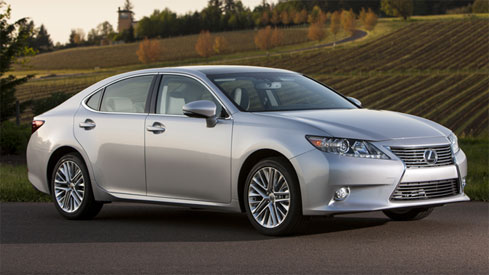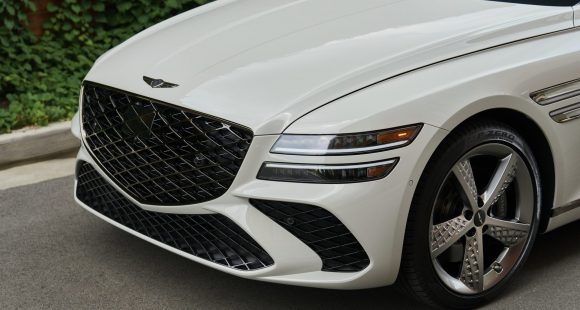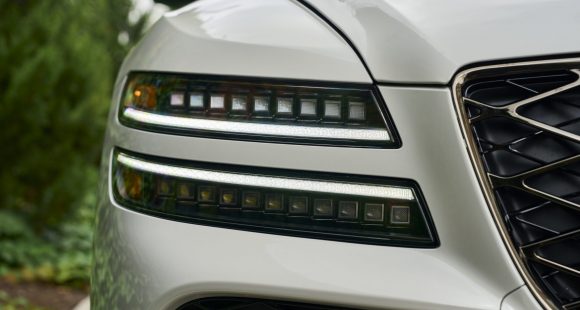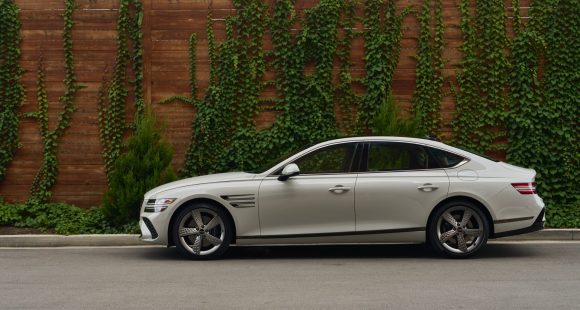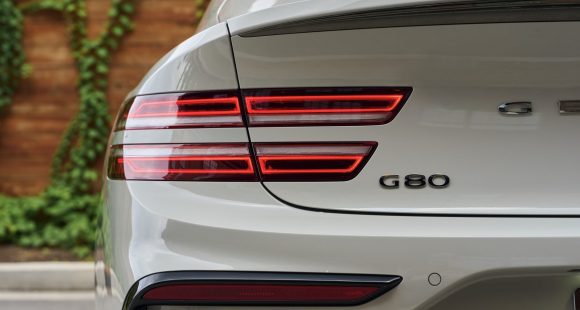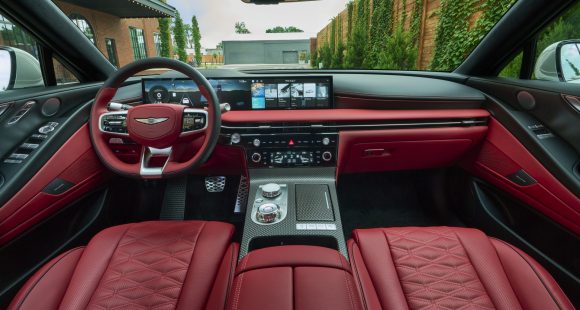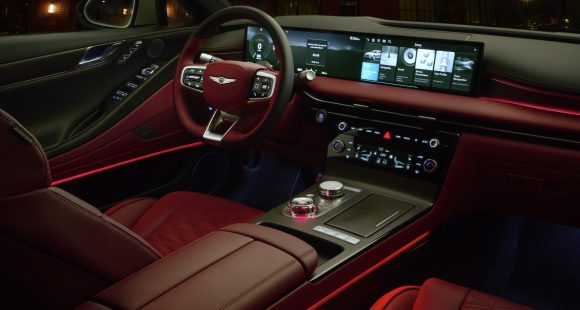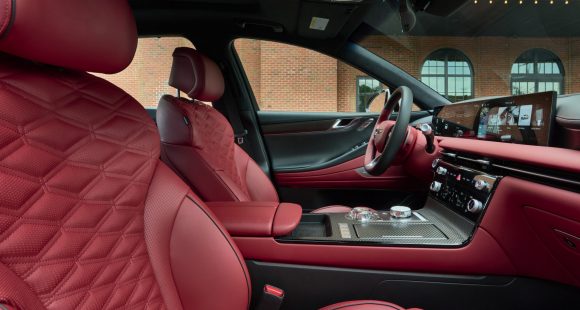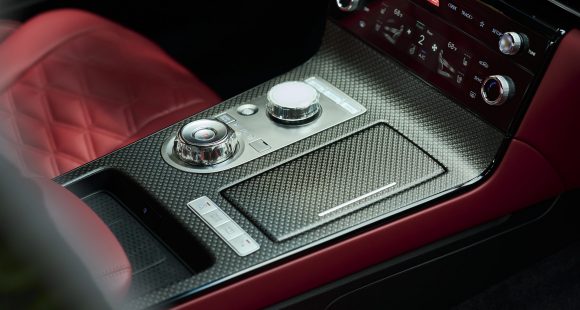2013 Lexus ES
While long the best selling car in the Lexus line-up, the ES has not only had to compete with other entry-level luxury sedans, it’s also had to stay a few notches above the increasingly lavish Toyota Camry on which it was based. Well, now it’s time for an all-new ES, with a new dimension, and some electrifying new hardware. Let’s drive the result!
It’s hard to believe that the 2013 Lexus ES is the 6th generation of the brands entry-level luxury stalwart. And, while it has evolved greatly over the years, never before has it seen such substantial change, as it is now based on the stretched Camry chassis of the upcoming full-size Toyota Avalon. That means a much bigger interior, with over 4-inches of added legroom for the back seat.
 While it’s true the Camry itself has gotten more refined and luxurious over the years, it simply can’t match the level of material quality or options you can get in the ES, like a 15-speaker Mark Levinson audio system, semi-aniline leather on the dash, along with Birdseye Maple or Bamboo wood trim. Navigation is not standard, but if you opt for it, inputs are by a much improved, second generation of Lexus’ remote touch system.
While it’s true the Camry itself has gotten more refined and luxurious over the years, it simply can’t match the level of material quality or options you can get in the ES, like a 15-speaker Mark Levinson audio system, semi-aniline leather on the dash, along with Birdseye Maple or Bamboo wood trim. Navigation is not standard, but if you opt for it, inputs are by a much improved, second generation of Lexus’ remote touch system.
NuLuxe fake leather is standard, but most cars will come fitted with the real thing covering very comfortable seat padding. 10 airbags and Lexus Safety Connect are standard, but not a backup monitor. Hi-tech safety options include Lane Departure Alert, Rear Blind Spot Monitoring, and Rear Cross Traffic Alert. Trunk capacity is 15.2 cubic feet, while the ES hybrid holds 20% less to make room for its battery. That’s right, after recently dropping the HS hybrid from the line-up Lexus has added a hybrid to the ES family, the ES 300h.
Styling is mostly the same for both the standard 350 and the 300h sedans, with a more aggressive look clearly aimed at decreasing the average ES buyer’s age. The front end is wider, nicely incorporating the Lexus family spindle grille, as well as lots of sharp lines. While the new ES is bigger in every dimension, overall length comes in just 1.6-inches longer at 192.7. There are lots of aero aids throughout, including on the door frames and tail lights. The hybrid adds rear spoiler and a hidden exhaust outlet, replacing the ES 350’s dual exhaust setup.
Powering the ES 300h is the Camry’s 2.5-liter I4-based hybrid system that delivers out 200-horsepower through a CVT transmission. The mainstream ES 350 uses a carryover 3.5-liter V6 that sends its 268-horsepower, along with 248 pound feet of torque through a 6-speed automatic. Both feature a Drive Mode selector with Normal, Sport, and Eco modes, with an EV setting for the hybrid.
The ES 350’s Government Fuel Economy Ratings are 21-City and 31-Highway, a slight bump over last year. While The ES 300h hybrid comes in at 40-City and 39-Highway giving the 300h an Energy Impact Score that’s about as good as it gets with annual oil consumption of just 8.2-barrels per year and only 3.7 tons of yearly CO2 emissions.
There’s a reason many of us use “quiet as a Lexus” when describing ultra-quiet cars, and indeed not much has changed there. But what has changed, is the ES350 has gotten a tiny bit more dynamic, but not at the risk of sacrificing any of the silkiness or extreme comfort that the brand is known for. Think smooth and easy, just like Lionel Richie.
 Suspension set-up consists of MacPherson struts up front and dual-link struts in the rear, and the ES remains front wheel drive only. Ride quality is plush, as the ES, unlike the recently revamped GS, makes no pretentions of being a sport sedan; it’s all about wrapping the driver in solid comfort and luxury. Electric Power Steering feels natural and a tad quicker than before. The driving experience of the hybrid is exactly the same, and we put it on par with the Infinti M for power-train smoothness. It’s very pleasant to drive, save for some uncharacteristic- for Lexus-engine noise. Power feels every bit as strong as the V6 too, where a nice hit of electric motor torque gets you up and going.
Suspension set-up consists of MacPherson struts up front and dual-link struts in the rear, and the ES remains front wheel drive only. Ride quality is plush, as the ES, unlike the recently revamped GS, makes no pretentions of being a sport sedan; it’s all about wrapping the driver in solid comfort and luxury. Electric Power Steering feels natural and a tad quicker than before. The driving experience of the hybrid is exactly the same, and we put it on par with the Infinti M for power-train smoothness. It’s very pleasant to drive, save for some uncharacteristic- for Lexus-engine noise. Power feels every bit as strong as the V6 too, where a nice hit of electric motor torque gets you up and going.
Pricing for the 2013 Lexus ES 350 is actually down a bit from last year, however, starting at $36,995 for the ES 350. The ES 300h hybrid goes for $39,745 or $2,750 more than the V6. You can tell designers put a lot of effort into making sure the 2013 Lexus ES lands well ahead of its rivals. It is a much better ES, one that should keep current owners happy, as well as attract new ones. With it no-compromise-on-luxury interior, and the addition of a very well executed hybrid, the new ES is a two-pronged approach that will spark plenty of sales.
Specifications
- Engine: 3.5-liter V6
- Horsepower: 268
- Torque: 248 lb-ft.
- EPA: 21 mpg city/ 31 mpg highway
2025 Genesis G80
New Interior And New Tech Elevates G80 Sedan
Talk about bad timing. This second-generation G80 debuted at the height of a global pandemic. But that hasn’t stopped Genesis or this Bentley-on-a-budget sedan. In fact, since then, Genesis has unveiled a spectacular all-electric version and now given all G80s a makeover. So, let’s find out what a better and better-timed new G80 is ready to deliver.
Breaking into the luxury sedan scene requires going up against traditional brands with long pedigrees and legions of loyal buyers. But Hyundai has never shied away from a challenge, and has made steady progress with their Genesis brand, and hopes that a revised 2025 G80 midsize sedan will be their next step up.
Styling matters more when you’re the upstart, and the Genesis Athletic Elegance theme changes very little for ’25; just a new grille, slightly reshaped bumpers, new wheels ranging from 18 to 20 inches, and an updated color palette. The G80’s unique two-line LED headlamps get revised Micro Lens Array technology that boosts performance while minimizing the brightness for oncoming drivers.
Changes inside are much more significant with an entirely new dash and console, eliminating both the hooded gauge panel and dashtop wide info screen. Merging them together into one 27-inch wide LG panoramic display than runs from behind the steering wheel to over the center stack. There’s a bigger and more comprehensive control panel in the center stack; while the console gets less armrest coverage, more space for storage, and reshaped cupholders. The wider display is still a touchscreen, but there is also a console mounted controller if you prefer to keep it fingerprint free. Both options work well, but the controller is still too easy to confuse with the dial-like shifter.
Materials are on par if not a notch above most European luxury rivals, and there are 18 speakers to crank out 1,400 watts of premium sound from Bang & Olufsen. Top Sport Prestige trim comes with Nappa leather seats, carbon fiber trim, micro-suede materials for the headliner and pillar covers, heated armrests, head-up display, and upgraded active safety features. Front seats are immensely comfortable without feeling overly soft, and there’s plenty of comfort and room for adults in the back seat.
More Bentley than Benz; streaking down the track with European-style solidity that gives you very little indication of the high speed you’re traveling at.
Same powertrains as last year. Base power comes from a 300-horsepower 2.5-liter turbo-four; the upgrade is this 3.5-liter twin-turbo V6 that outputs 375 horsepower and 391 lb-ft of torque. Both are hitched to standard all-wheel drive. At our Mason Dixon Dragway test track, the AWD delivered enough grip for consistent slip-free launches. We hit 60 in 5.0 seconds flat. Run after run, the 3.5T pulled as strong as it sounds. All G80s work with the same paddle-shift eight-speed automatic transmission, and while shifting was silky smooth on the street, here on the track with Sport Mode and wide-open throttle they were noticeably firmer and quicker.
It was a very surreal experience in the cabin. More Bentley than Benz; streaking down the track with European-style solidity that gives you very little indication of the high speed you’re traveling at. For us, that was 105 mph in 13.4 seconds at the quarter. In addition to the G80’s Sport Mode that tightens steering, improves throttle response, adjusts shifting points, firms up the suspension, and reconfigures stability system parameters; Sport Prestige trim adds rear-wheel steering and an electronic limited slip differential. But, even with all of that, it didn’t feel overly sporty in our handling course. Now, we were able to comfortably carry quite a bit of speed through the cones, but there was just an overall soft, somewhat disconnected and heavy presence that had us unsure of how hard we could push. Sport Prestige also adds upgraded performance brakes. They were plenty capable, bringing this 4,600-lbs. luxury liner consistently down from 60 in just 104 feet with little fade.
Government Fuel Economy Ratings for the six-cylinder are 16 City, 24 Highway, and 19 Combined. We averaged a good 21.3 mpg of Premium. Still, that’s a slightly below average Energy Impact Score, using 15.7 barrels of oil annually with 7.8 tons of CO2 emissions.
Considering the amount of luxury packed into the G80, its $58,350 starting price, even though slightly higher than last year, remains pretty remarkable. It’s a substantial step up to the 3.5T though, as it begins at $70,850.
Genesis has existed as a standalone luxury brand for just less than a decade, and it has indeed been making steady progress into what is surely the hardest segment of all to master. The 2025 Genesis G80 sedan continues to impress and is a great option for luxury-minded buyers who prioritize true value over badges.
Specifications
As Tested
- Engine: 3.5-liter twin-turbo V6
- Transmission: eight-speed automatic
- Horsepower: 375
- Torque: 391 lb-ft
- EPA: 16 City | 24 Highway | 19 Combined
- 0-60 mph: 5.0 seconds
- 1/4 Mile: 13.4 seconds at 105 mph
- Braking, 60-0 (avg.): 104 feet
- MW Fuel Economy: 21.3 mpg (Premium)




